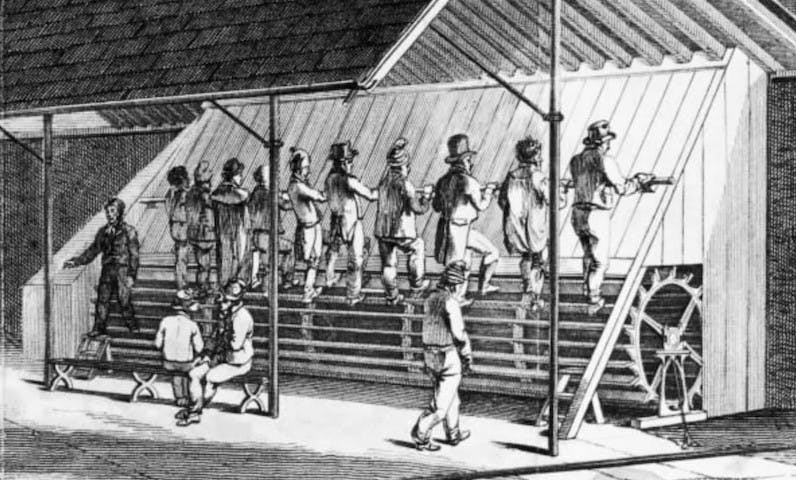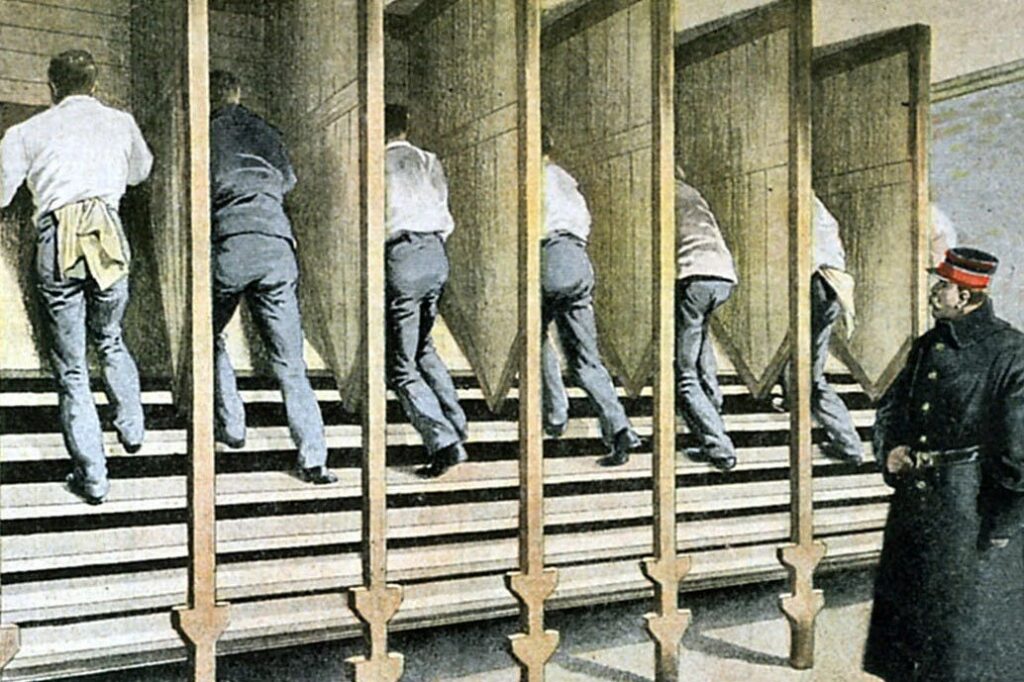THE DISTURBING HISTORY FUELING YOUR WORKOUT
Glancing at the treadmills lined up in your gym, you’d never guess the sinister backstory behind this popular workout machine. Before treadmills built athletes, they brutally punished prisoners. Those first “treadwheels” crippled inmates for months through endless monotonous climbing. So how exactly did appliances designed to shatter convicts become today’s go-to fitness equipment? The surprising journey reveals dark origins we forget each time we “dreadmill” in the gym.


INVENTED AS TOOLS FOR SUFFERING
Our story opens in 19th century Britain. Rising crime plagued cities and idleness corrupted prisons. Seeking solutions in 1818, Sir William Cubitt devised an imposing wooden wheel covered in isolated compartments for inmates. Up to 40 prisoners at once stepped upwards in place for hours powering its rotation. This endless “everlasting staircase” aimed crushing inmates’ will through toilsome labor.
Dubbed the “treadwheel,” Cubitt’s torture device became widely deployed for reforming criminals. Oscar Wilde penned an agonized poem after two years treading a wheel shredded his health. But while the wheels efficiently delivered suffering, authorities eventually recognized permanent damage outweighing any redemption. So Britain banned treadwheel use by 1898 for extreme cruelty. Yet little did Cubitt or authorities know that versions of his instrument would someday propel world fitness rather than punish prisoners.

FROM PUNISHING HEARTS TO STRENGTHENING THEM
As an urbanized 20th century ushered sedentary living, exercise gained new appeal for battling modern woes. Treadwheels conceptually reemerged as research tools gauging patient heart rates during motion. Modifying cattle treadmills in the 1940s, Seattle cardiologist Dr. Robert Bruce developed gentle walking tests revealing cardiac weakness through monitoring electrocardiogram (EKG) readouts. First used upholding astronaut fitness standards, the tests uncovered silent heart conditions and saved lives.
This promising diagnostic utility restored reputations for Cubitt’s demonic invention. Exercise physiologist Dr. Kenneth Cooper next confirmed cardiorespiratory fitness strengthens the heart through his landmark 1968 book “Aerobics” advocating running. Cooper’s military research had employed treadmills quantifying exertion thresholds. Now enshrined as medical instruments and training aids, treadwheels seemed reformed from penal legacy. Yet drab decor still inspired bored misery users yearned escaping. An inventive New Jersey engineer named Bill Staub set sights on renovating that reputation next.
BRINGING TREADWHEELS HOME
In the 1960s, few suburban homes housed exercise equipment beyond scattered dumbbells. Barred from running outdoors through harsh New Jersey winters, ex-jet engineer Bill Staub instead jury-rigged a motorized treadbelt from wooden rollers in his basement. Mimicking walking by adjusting the speed dial, early “treadmill prototypes let Staub train year-round chasing fitness milestones promoted by exercise guru Cooper without leaving home.
Sensing dilettante interest, Staub launched production of his PaceMaster treadmill via mail order in 1968. Costing today’s equivalent of $3,000, Staub’s “ Basement Jogger” became the first machine marketing cardio training to consumers. Rival brands materialized once Staub proved home treadmill demand. Marketers now promised treadwheel workouts fostering wellness rather than inmate torture.
Sales boomed through the 1970s running craze. But while 50 million Americans now tread yearly, critics echo convict laments given 30% gather dust swiftly post-purchase as novelty fades. Can we break torturous reputations beyond glossy infomercial depictions? Modern inventors keep working towards that transformation.
TODAY’S TORTURE-FREE TREADMILLS?
Given most loathe treadmills despite owning them, innovators try rescuing workouts from tedium through creative variety transforming drudgery into adventure. Some approaches add tornado simulation for sprinters, video classes led by coaches, or immersive video game worlds full of alien creatures and fantasy quests unfolding through miles traveled. Participants now train alongside fellow cyclist avatars chasing checkered flags or stride across Google’s Street View chasing scenery from Machu Picchu to Grand Canyon trails.
The most captivating trend transforms treadmills into portals venturing anywhere on Earth without leaving home. NordicTrack’s patented design revolutionized machinery constricted as flat motorized tracks by introducing adjustable inclines. Gradually sloping treadmills mimic real running courses down to descending mountain trails, not just upwards hiking. Hands-free controls automatically match video footage pace evacuating the sensation of marathon monotony.
Has NordicTrack perfected the treadwheel legacy besieged by torture complaints since Cubitt’s primitive paddles? Early reviews praise the immersion sensation finally achieving inventor Staub’s initial suburban convenience vision. And improved exercise adherence makes the upgraded daily treadmill grind easier embracing than previous generations endured.
LEGACY OF REIMAGINING SUFFERING
From British prisons to American basements towards global connectivity, treadmills symbolize cultural imagination’s power redefining reviled objects through reenvisioning value. Had authorities banished Cubitt’s torturous innovation outright back in 1898, cardio medicine and historic fitness revolutions may have unfolded very differently.
Instead, transformative minds redeemed the treadwheel’s potential – migrating a mechanism of institutional suffering towards elevating health for all. Reform now spurs rehabilitation. What once inflicted humiliation offers personal power over the modern epidemics of obesity and heart disease. Stares of anxiety replaced by affirmation in the mirror.
There is poetic justice witnessed each day through throngs dynamically walking, running and climbing together in rhythm united by motivation versus restraint. Though fiberglass and silicon machinery updated materials, Cubitt might still recognize kindred spiraling momentum echoed from his 19th century lumber invention. Yet rather than crushing of convict spirit, devotees now reinforce persevering commitment to self-improvement first sparked by misfortune.
So while “dreadmills” remain logged by some, for others each step powers purpose strong enough overpowering adversity’s lingering ghosts. Our shared progress was only possible reimagining anguish into inspiration when trapped fate seemed sealed. And the vista widens ahead wherever reclaiming pain for gain points progress next.
